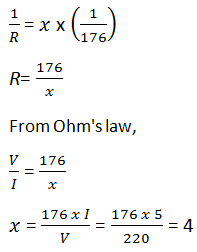NCERT Solution: Electricity
An electric bulb is rated 220 V and 100 W. When it is operated on 110 V, the power consumed will be –
(a) 100 W
(b) 75 W
(c) 50 W
(d) 25 W
Ans (d) 25 W
(d)Energy consumed by an appliance is given by the expression,


Where,
Power rating, P = 100 W
Voltage, V = 220 V
Resistance, R = 
The resistance of the bulb remains constant if the supply voltage is reduced to
110 V. If the bulb is operated on 110 V, then the energy consumed by it is given
by the expression for power as

Therefore, the power consumed will be 25 W
Two conducting wires of the same material and of equal lengths and equal diameters are first connected in series and then parallel in a circuit across the same potential difference. The ratio of heat produced in series and parallel combinations would be –
(a) 1:2
(b) 2:1
(c) 1:4
(d) 4:1
Ans (c) 1:4
(c) The Joule heating is given by, H = i2Rt
Let, R be the resistance of the two wires.
The equivalent resistance of the series connection is RS= R + R = 2R
If V is the applied potential difference, then it is the voltage across the
equivalent resistance.

The heat dissipated in time t is,

The equivalent resistance of the parallel connection is RP=

V is the applied potential difference across this RP.

The heat dissipated in time t is,

So, the ratio of heat produced is,

Note: H α R also H α i2 and H
α t. In this question, t is same for both the circuit.
But the current through the equivalent resistance of both the circuit is
different. We could have solved the question directly using H
α R if in case the
current was also same. As we know the voltage and resistance of the circuits, we
have calculated i in terms of voltage and resistance and used in the equation H
= i2Rt to find the ratio.
To measure the potential difference between two points, a voltmeter should be connected in parallel to the points.
A copper wire has diameter 0.5 mm and resistivity of 1.6 � 10−8Ω
m. What will be the length of this wire to make its resistance 10 Ω? How much
does the resistance change if the diameter is doubled?
Answer
Area of cross-section of the wire, A =π (d/2) 2
Diameter= 0.5 mm = 0.0005 m
Resistance, R = 10 Ω
We know that

Therefore, the length of the wire is 122.7 m and the new resistance is 2.5 Ω.
| I (amperes ) | 0.5 | 1.0 | 2.0 | 3.0 | 4.0 |
| V (volts) | 1.6 | 3.4 | 6.7 | 3.0 | 13.2 |
Plot a graph between V and I and calculate the resistance of that resistor.
The plot between voltage and current is called IV characteristic. The voltage is plotted on x-axis and current is plotted on y-axis. The values of the current for different values of the voltage are shown in the given table.
| V (volts) | 1.6 | 3.4 | 6.7 | 3.0 | 13.2 |
| I (amperes ) | 0.5 | 1.0 | 2.0 | 3.0 | 4.0 |
The IV characteristic of the given resistor is plotted in the following figure.

The slope of the line gives the value of resistance (R) as,
Slope = 1/R = BC/AC = 2/6.8
R= 6.8/2 = 3.4 Ω
Therefore, the resistance of the resistor is 3.4 Ω.
Resistance (R) of a resistor is given by Ohm�s law as,V= IR
R= V/I
Where,
Potential difference, V= 12 V
Current in the circuit, I= 2.5 mA = 2.5 x 10-3 A
![]()
Therefore, the resistance of the resistor is 4.8 kΩ
There is no current division occurring in a series circuit. Current flow through the component is the same, given by Ohm’s law as
V= IR
I= V/R
Where,
R is the equivalent resistance of resistances 0.2 Ω, 0.3 Ω, 0.4 Ω, 0.5 Ω and 12 Ω. These are connected in series. Hence, the sum of the resistances will give the value of R.
R= 0.2 + 0.3 + 0.4 + 0.5 + 12 = 13.4 Ω
Potential difference, V= 9 V
I= 9/13.4 = 0.671 A
Therefore, the current that would flow through the 12 Ω resistor is 0.671 A.
For x number of resistors of resistance 176 Ω, the equivalent resistance of
the resistors connected in parallel is given by Ohm�s law asV= IR
R= V/I
Where,
Supply voltage, V= 220 V
Current, I = 5 A
Equivalent resistance of the combination = R,given as

Therefore, four resistors of 176 Ω are required to draw the given amount of
current.